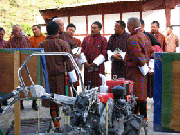Keiji Nishioka: A bridge between two nations
At a time when Japan’s economy was in a bubble stage, when the Japanese people were considering TV, washing machine, refrigerator as necessities at their homes, a Japanese youth, an agriculture expert was writing development plans in a remote village in Bhutan under a lamp-light lit from pine extract. The agricultural development in Bhutan and Japan-Bhutan relationship came out as a one man initiative of this planner, Keiji Nishioka.
In 1962, the then Prime Minister of Bhutan Jigme Palden Dorji made a request to one of his Japanese friends, Nakao Sasuke, for an agriculture expert to plan agricultural development in Bhutan. Sasuke recommended one of his students, Keiji Nishioka. Keiji was familiar with Himalayas through his expeditions.
One fine day in 1962, Keiji and his wife Satoko reached the Prime Minister’s residence, the Bhutan House in Kalimpong. His destiny was penned that day. Two years later, the couple left industrialized Japan for rural Bhutan. They flew to Calcutta airport and then to Hashimara. From there a jeep sent by Bhutanese government took them to Paro where his destiny was waiting for them. Then, he was 31. Initially, Keiji worked as a member of Japan’s Overseas Technical Cooperation Agency (now JICA) under the Colombo Plan. His earlier days were more challenging than imagined. He was in a remote area. He had to work with boss and colleagues from India who were cynical to believe that an expert from an island country has anything to do with the mountainous country than waste the resources. He had to either quit or prove them wrong. He started a small experimental farm, hired young boys as apprentices and began promoting products from his farm. He used seeds from Japan and the products attracted the farmers. Year by year, he increased the size of the farm, and amount and varieties of products. He experimented Japanese rice, large cabbage and long radish; grew asparagus, onion, potato, tomato, melon, watermelon, apple, cherry, grapes, persimmon, peach, pear, strawberry and everything the climate permitted. He grew improved varieties of vegetables, cereals, fruits and trees, and distributed seeds. The farmers were attracted; he worked with them and initiated selling of vegetable in the market. Before this, farmers had no idea if they had any products that would fetch them money. He took the farmers to markets, as far as to Thimphu and Phuntsholing, to sell their products.
After four years, upon his request, Japanese government started sending farm machineries. He taught improved cultivation methods and management techniques. In June 1974, during the coronation ceremony of the fourth monarch of Bhutan, the fresh fruits and vegetables from his farm were on the table for the royal guests. He walked around the country observing people’s works, listening to their stories, giving them advices and distributing seeds. He trained youths in farming techniques and sent students to Japan for trainings. He was entrusted the entire development of Zhemgang, one of the rural districts, where shifting cultivation was practiced and no rice fields existed. The district was not connected by roads and his two children were nearing school going age. So, he sent his wife and children to Japan and continued his development exercises in the remote Himalayan Mountains. He coordinated Zhemgang Integrated Area Development Project; introduced agar wood from neighboring Assam in India, cardamom from neighboring district Gelephu; and started their plantation as cash crops. He groomed apprentices, constructed rice fields, and introduced high yielding varieties of cereals, fruits and vegetables. Besides agricultural development, he mobilized people’s participation to construct suspension bridges, irrigation canals, farm roads, health clinics, sanitation and disseminated concept of healthy cooking and safe meat preservation methods. By now he was a national hero known as Japan “sahib” or the Lord.
Bhutan and Japan are distinct in many ways, yet Keiji Nishioka chose to seek uniformities. Born on St. Valentine’s Day of 1933, educated in Sakuragaoka Primary School in Seoul, Korea, Yao Junior High School in Osaka and Osaka Prefecture University, Keiji spent his life serving the farmers of Bhutan. In 1980, the monarch conferred to him a red scarf and a title of ‘Dasho’ equivalent to ‘Sir’, for his selfless service, making him the first foreigner to earn the title. In 1983, an international airport was built near to his farm, in Paro. Three years later, Japan and Bhutan signed a formal diplomatic tie and a year later in 1987, Japanese Prince Naruhito visited Bhutan. In all these mega events, Dasho Keiji Nishioka was the center of talks and the farm established by him was a ‘must-visit’ venue. He spent twenty eight restless years in Bhutan. On March 21, 1992, a toothache stole away his soul from his body in Thimphu hospital. On March 26 a state funeral in his name drenched Paro valley with the tears of the farmers and officers alike and the whole nation was soaked in grief. In 1999, he was awarded meritorious ‘Druk Thugsey Award’ posthumously, for his contributions to the development of agriculture productions in the country.
Today, Nishioka bridge in Zhemgang, Bonday farm in Paro, Agriculture Machinery Centre, National Seed and Plant Protection Program, roads, hospitals, thousand of fruit trees, hundreds of agriculture veterans, high yielding varieties of rice, vegetables, fruits and trees, made-in-Japan farm machineries and automobiles all over the nation are the results of his vision and dedicated service to the Bhutanese people. The name of Dasho Keiji Nishioka ties the people and governments of Japan and Bhutan with hearty spiritual knot initiated by him. …………..

